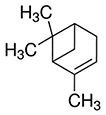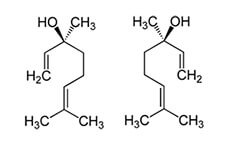
Before we rush into the importance of terpenes, let’s first go over what a terpene actually is. A terpene, also scientifically referred to as an isoprenoid, falls under the multifaceted class of organic compounds – specifically the aromatic hydrocarbons, consisting of multiple repeating linked isoprene subunits.
In order to be considered a terpene, a molecule has to exhibit the proper structure. These subunit compounds can be arranged in a variety of ways from 5-carbon rings to 5-carbon chains, resulting in over 30,000 different terpene isomers (same formula, different arrangement of atoms).
You’re probably wondering why all this matters – especially if you aren’t too chem savvy. Well, given this chemical makeup, terpenes have the potential to be useful and quite therapeutic.
Terpenes are probably the coolest of aromatic communicators. Seen in plants, fruits, trees, cannabis, and insects, terpenes are commonly used to communicate within their species, like pheromones. Unlike pheromones, though, terpenes are capable of transmitting information across different species – an absolutely incredible trait, biologically speaking.
So, let’s go into how and why terpenes are useful.
These powerful aromatic organic compounds are secreted as a defense mechanism to protect host plants by deterring plant predators – often by attracting the predators of herbivores and sending out “warning signs” to herbivores (if poisonous).
(If only humans adapted such an evolutionary advantage – you could give off invisible chemical signals to tell certain people it’s just not your day.)
Given the complexity of terpene chemical signaling, the study of these easily evaporated compounds has been of great interest to many biologists. Scientists are working to understand the scope at which terpenes can interact. They hope not only to incorporate more profound pharmacological implications but also to make more practical advancements in the field of agriculture.
Perhaps we are getting too technical – but hang in there; the good part comes next!
Terpenes also attract pollinators, interact with cannabinoids, and have a wide array of potential medicinal effects. The uses, benefits, and functions are rather widespread. Some may be helpful in relieving stress (aromatherapy), pain, inflammation, appetite, and bacterial infections, as well as, elevating mood. Others may help with cognitive abilities like focus and memory.
Nevertheless, please remember that our products are not intended to treat, cure, or diagnose any of the conditions mentioned above.
Secreted in glandular trichomes, the same glands that construct cannabinoids like THC and CBD, terpenes are the building blocks for more complex cannabinoids as well as the aromatic oils that give cannabis its distinguishing flavors and pungent smells.
From sweet and fruity to skunky and sour, the smells produced by cannabis can be extremely distinct. What might surprise you is that the chemical structure of terpenes within marijuana will affect not only the smell but also the psychoactive effects produced when smoked or consumed.
Some popular cannabis terpenes you may have heard of are monoterpenes (responsible for most of cannabis’ essential oil), diterpenes and sesquiterpenes. Depending on the strain, the terpenes within marijuana can have a multitude of potential therapeutic effects. This is because of their action of binding to receptors within the brain, affecting the chemical output of neurotransmitters.
For those of you not too knowledgeable in neuroscience, neurotransmitters are the little drifting communicators gossiping all kinds of important information to the receptors they bind with.
Terpenes are capable of combining with or dissolving in lipids or fats as well as permeating the blood-brain barrier. They can target the dopaminergic, noradrenergic, and serotonergic neurons, inducing heightened appetite, happiness, feelings of ease, and our ability to sleep. Remember, neurons are the nerve cells in the brain responsible for our ability to understand and be the humans we are.
Using neurotransmitters as teenie weenie communicators, neurons cover a vast amount of psychological functions. By heightening the amount of dopamine and GABA neurotransmitter levels within the synaptic clefts (areas between neurons where chemical communication takes place) as well as mimicking the actions of serotonin reuptake inhibitors.
Then there are terpenoids, terpenes’ half-siblings. The major difference here is that terpenoids have been denatured after chemical modification (drying and curation) via oxidation whereas terpenes are the purely naturally occurring hydrocarbons. In most cases, the two terms are used interchangeably – just know that any terpenoid once started off as a young terpene lad.
Given extensive research in the field of psychopharmacology, it has been theorized that, due to the biological components of terpenes, cancer chemopreventive effects, antimicrobial, antifungal, antiviral, antihyperglycemic, anti-inflammatory, and antiparasitic properties have been strongly linked to the consumption of terpenes. The authors of the PubMed article Terpenes: substances useful in human healthcare state that terpenoids should absolutely be seen more often in modern medicine, though it needs to be studied further. (1)
We recommend conducting your own research to understand the latest data on the subject.
When it comes to the synergistic relationship between cannabinoids and terpenes, things become interesting. Both share the same biosynthetic pathways, but since terpenes are simply responsible for the aroma produced by cannabis, the addition of cannabinoid-induced effects can result in synaptic plasticity (learning and memory purposes) as well as an increase in the strength of THC, when present.
Studies have indicated that, given the presence of both cannabinoids and terpenes, those who use marijuana products may experience an increase in blood flow, enhanced cortical activity, and rejection of respiratory pathogens like MRSA. In a September 2011 report, Ethan Russo went a step further and stated that the chemical interaction could be seen to address severe pain, inflammation, diagnosed depression, anxiety disorders, drug addiction, epilepsy, carcinogenic cells, fungal and bacterial infections. (2) Again, further studies and research need to be conducted on the matter.
The cannabinoid THC is well known for its vast array of potential applications. THC is the most prevalent and psychedelic component in marijuana. The synergetic relationship between terpenes and THC is reported to be more practical in treating medical marijuana patients. According to several studies done within the past decade, the presence of both compounds was related with a far more rapid onset of muscle relaxation as well as anticonvulsant properties in comparison to THC alone.
The most important finding appears to be that terpenes may serve as inhibitors to THC’s intoxicating effects, thereby inducing the cathartic effects often observed.
CBD Hemp Oil has gained a major amount of popularity over the past couple of years because it lacks the psychoactive properties associated with THC. Naturally abundant in terpenes, CBD hemp oil is a natural botanical concentrate high in cannabidiol. Often infused with potentially beneficial ingredients such as omega-3 fatty acids, vitamins, chlorophyll, and amino acids, CBD hemp oil has been reported to help with discomfort and related stressors due to its calming effects. However, our products are not intended to treat or diagnose any medical conditions.
Depending on the amount (and kind) of terpenes present, the manner in which both the cannabinoid and the isoprenoid interact within the brain can vary. In the following section, the chemical components and general classifications of different terpenes will be discussed.
By definition, the entourage effect is essentially the synergistic communication among multiple compounds in marijuana or CBD hemp oil, like THC, terpenes, and other cannabinoids. Given this synergistic mixture, a multitude of enhanced positive effects may arise given one substance’s influence upon another. When isolating each individual component, the differences in the effects become apparent.
Ok, here comes the fun part. Since strains of marijuana can vary so greatly, the Green House Seed Co. found it helpful to incorporate a detailed infographic “flavor wheel” so that medical marijuana patients could determine which strain would produce their desired effects. Super cool, right? The terpene wheel is an extremely useful data chart to determine which terpene and, therefore, which type of strain is best for a specific purpose based on a number of factors.
Despite the variance of the wheels (companies set out to create their own wheels to market their own products), a very common one contains the name of six popular terpenes as well as the respective boiling point, aroma, and potential psychological and physiological effects, other fruits or plants in which they are also found, key elements, and possible medicinal benefits.
This wheel is best for beginners, but usually, any kind of terpene wheel is easy to use and understand. It’s just that that simpler ones can be quite useful for those who have little to no background in the subject but believe they will benefit from its use.
There are over 200 different kinds of terpenes present in cannabis, mainly broken down into the spicy, bitter, sweet or sour types. Limonene, myrcene, pinene, and linalool are some common terpenes you may have already heard of. Each is found in a different host and exhibits a slightly different effect.
Let’s delve into each one. (An image of the organic compound’s chemical structure will also be included for each terpene.)
Limonene is a cyclic carbohydrate found in many fruits commonly used for flavoring, cosmetics, anti-fungal applications, weight-loss, and cleaning purposes. Its aroma is quite citrusy. It can quickly pass through the blood-brain barrier (a really important membrane that separates circulating blood from extracellular fluid in our brain) and causes a possible increase in systolic pressure as well as an acuity in attention, focus, and libido.
Limonene has exhibited muscle-relaxant and anxiolytic effects as well as antidepressant effects due to a rise in synaptic levels of serotonin and dopamine.
In addition to this, this citrusy terpene has been recommended for anti-carcinogenic treatment due to the potential to promote apoptosis (cell death) of cancer cells. Most notably, Limoneno was just recently patented, which helps significantly against gastroesophageal reflux. A common strain of weed containing this terpene is Super Lemon Haze (indica).

Myrcene is the most common terpene found in cannabis, responsible for producing a very earthy and mildly fruity scent. Most of us have likely come across strains containing this terpene and would probably be able to identify the smell quite easily.
Among some of its potential beneficial analgesic, anti-inflammatory, anti-mutagenic and antibiotic properties, usage of this terpene may leave you antispasmodic and sedative, which may also help those with sleep concerns.
The synergic relationship between THC and myrcene increases the psychoactive properties of THC. It has been noted that this musky terpene also lowers the resistance across the blood brain barrier, allowing substances like cannabinoids to potentially flow in more easily.
Additionally, the Bonamin et al. study indicated that there were strong correlations between the prevention of peptic ulcer disease and the usage of myrcene. A common strain containing this terpene is Lovrin 110 (indica) – but don’t get too carried away with your consumption of this strain unless you want to risk being couch-locked.

Unsurprisingly, the bicyclic monoterpenoid terpene pinene omits an odor very similar to that of pine and fir trees. Given extensive studies, this terpene has exhibited potential applications as it is commonly used as an expectorant, bronchodilator (it has a widening effect on the bronchi), anti-inflammatory, anticarcinogenic and a local antiseptic.
According to the Alchimia blog on Marijuana Terpenes and Their Effects, pinenes may prevent the decay of molecules responsible for the passing of information, resulting in the improvement of memory. (This effect was introduced earlier, but this is the terpene directly responsible for such prevention.) ()5)
In relation to its interaction with THC, it has been observed that pinene may counteract the effects of THC, thus decreasing the amount of acetylcholine (stress hormone) in the synaptic cleft between neurons. This, in turn, may help improve concentration, well-being, and drive.
Interestingly, the addition of pinene to THC produces a synergistic effect that helps with the inhibition of sharp short-term memory when THC is consumed on its own. A common strain containing this terpene is Trainwreck (sativa).

The aroma of this particular non-cyclic monoterpenoid terpene has been described as floral with a hint of spice and lavender undertones – a very pleasant smell indeed. Commonly found in lavender, linalool has been seen to aid patients experiencing mild to severe pain, weak immune systems, emotional distress, insomnia, cognitive disabilities, convulsions, lung inflammation, epileptic seizures, anxiety, and carcinogenic cells. In a test performed on laboratory mice, it was observed that their locomotor activity had decreased by 75% once linalool was administered. (5) Though further study is needed.
When both linalool and THC are either smoked or consumed together, data shows that the anxiety often provoked by pure THC subsides substantially, placing linalool as an extremely helpful compound in the treatment of psychosis and anxiety. A common strain containing this terpene is Amnesia Haze (sativa dominant).

For cannabis-derived terpenes, Blue River Extracts (6) may be your best best as far as their ratings go. However, the prices will be higher in comparison to non-cannabis-derived terpenes, which can be purchased through Denver Terpenes (7) or CBDistillery (8).
But when it comes to quality, a terpene is a terpene. You can expect to pay higher prices for those products derived from cannabis because it is rather difficult to isolate the terpenes – the percent yield is fairly low, and very high-quality marijuana is typically needed.
Despite being a novel topic with little research, the usage of terpenes has exhibited exponential growth in popularity both medicinally and recreationally due to their potential therapeutic applications.
Given a growing amount of research and data on the topic, we hope to see a future where people have an even greater understanding of both the biological basis of terpenes and their beneficial traits. That said, we encourage you to do your own research on the topic before drawing any conclusions.